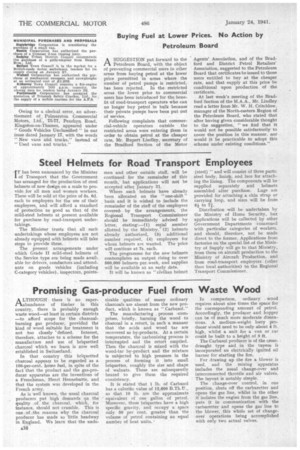Promising Gas-producer Fuel from Waste Wood
Page 18

If you've noticed an error in this article please click here to report it so we can fix it.
A LTHOUGH there is no super4-1.abundance of timber in this country, there is probably enough waste wood—at least in certain districts —to afford scope for the charcoalburning gas producer, provided the kind of wood suitable for treatment is not too closely defined. Interest, therefore, attaches to a scheme for the manufacture and use of briquetted charcoal which we learn is now well established in Switzerland.
In that country this briquetted charcoal appears to be regarded as a 100-per-cent, home fuel, in spite of the fact that the product and the gas-producer apparatus are the inventions of a Frenchman, Henri Hennebutte, and that the system was developed in the French army.
As is well known, the usual charcoal producers put high demands on the quality of the charcoal, which, for instance, should not crumble. This is one of the reasons why the charcoal producer has made so little headway in England. We learn that the nude
sirable qualities of many ordinary charcoals are absent from the new product, which is known as " Carbusol."
The manufacturing . process -comprises, briefly, burning the wood to charcoal in a retort, in such a manner that the acids and wood tar are recovered as by-products. At a certain temperature, the carbonizing process is interrupted and the retort emptied. Then the charcoal is mixed with the wood-tar by-product and the mixture is subjected to high pressure in the process of forming it into small briquettes, roughly the size and shape of walnuts. These are subsequently heated to give them the required consistency.
It is stated that 1 lb. of Carbusol has a calorific value of 12,600 B.Th.U., so that 10 lb. are the approximate equivalent of one gallon of petrol. Moreover, these briquettes have a high specific gravity, and occupy a space only 50 per cent. greater than the volume of petrol containing an equal number of heat units. • In comparison, ordinary wood requires about nine times the space for the corresponding amount of petrol. Accordingly, the producer and hopper can be of much more moderate dimensions. A medium-weight lorry producer would need to be only about 4 ft. high, whilst a unit for a van or car could be built to a height of 3 ft.
The Carbusol producer is of the crossdraught type and in the tuyere is incorporated an electrically ignited oil burner for starting the fire.
For drawing up the fire a blower is used, and the mixing apparatus includes the usual change-over and interconnected throttle and air valves. The layout is notably simple.
The change-over control, in one position, shuts off the carburetter and opens the gas line, whilst in the other it isolates the engine from the gas line, puts it in communication with the carburetter and opens the gas line to the blower, this whole set of changeover operations being accomplished with only two actual valves.




















































